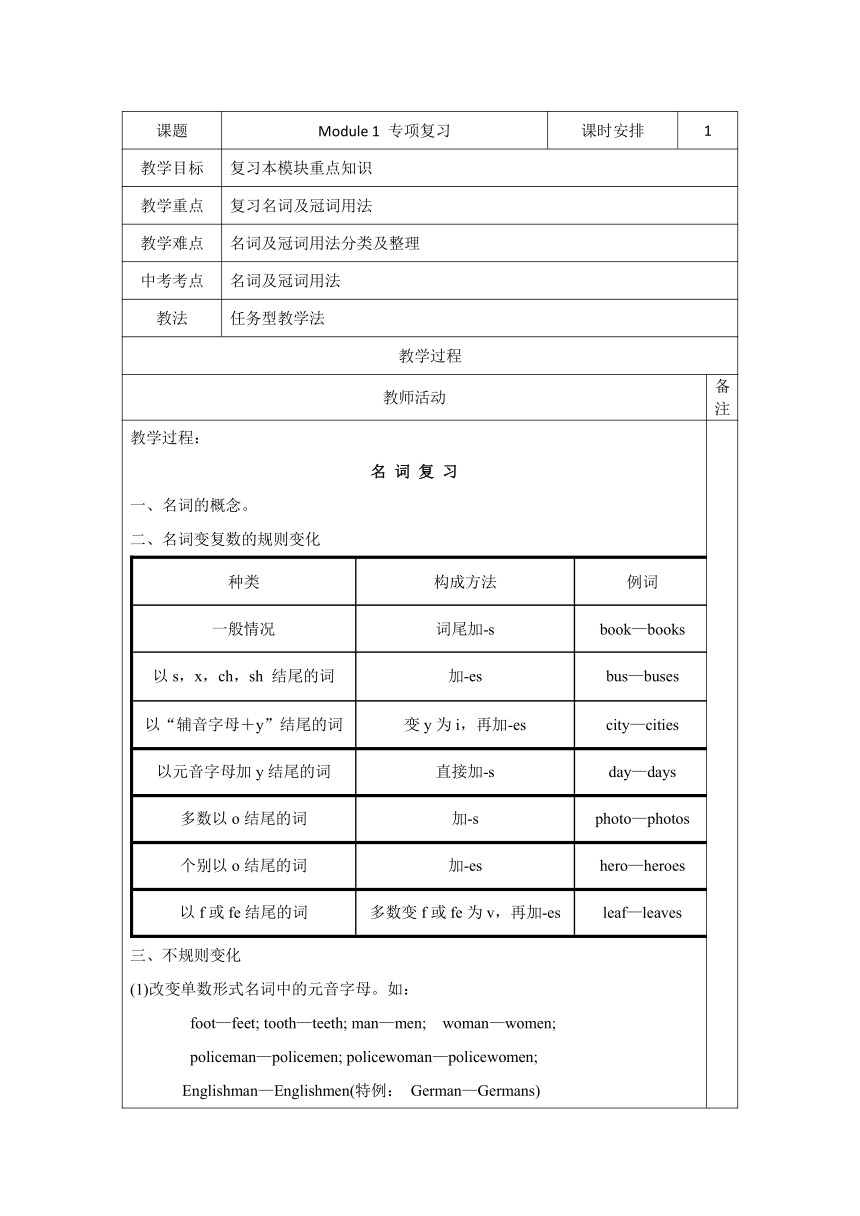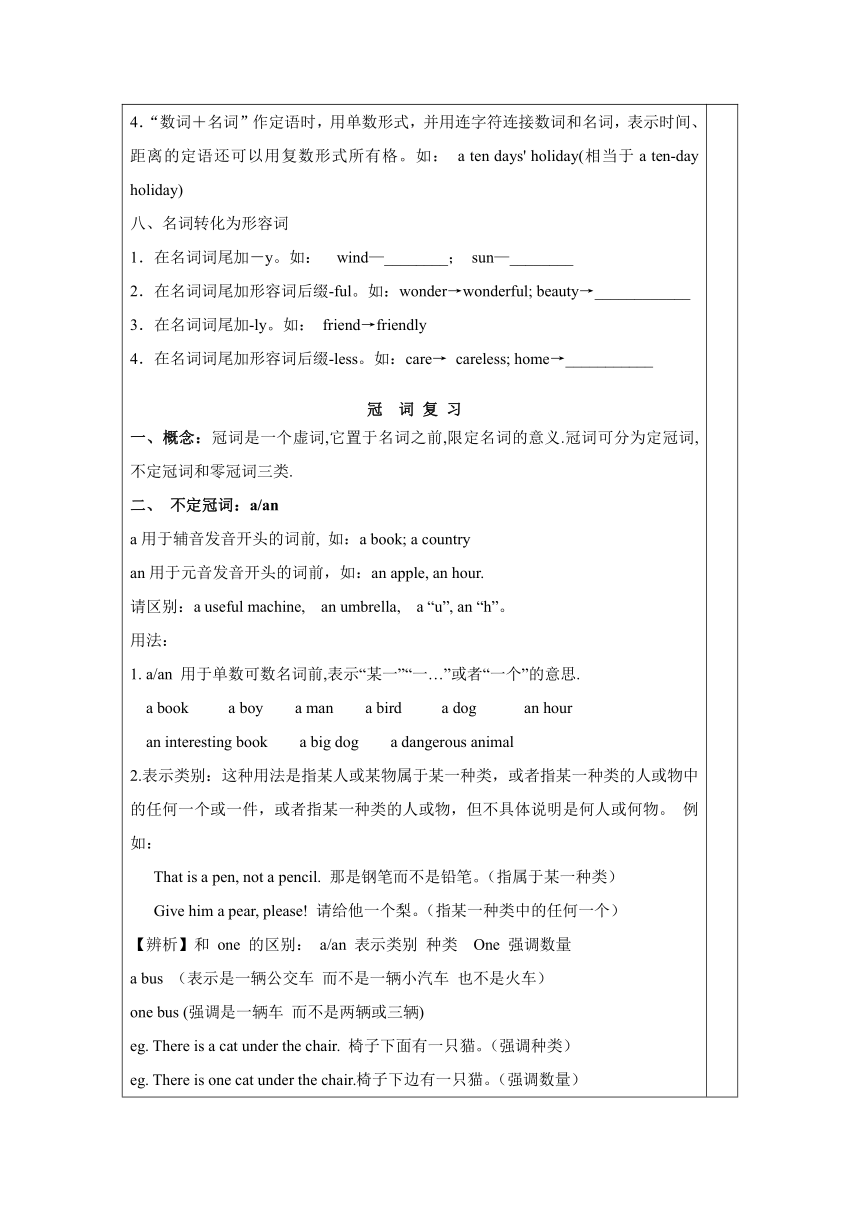 资源简介
资源简介
课题 Module 1 专项复习 课时安排 1
教学目标 复习本模块重点知识
教学重点 复习名词及冠词用法
教学难点 名词及冠词用法分类及整理
中考考点 名词及冠词用法
教法 任务型教学法
教学过程
教师活动 备注
教学过程: 名 词 复 习 一、名词的概念。 二、名词变复数的规则变化 种类构成方法例词一般情况词尾加-sbook—books 以s,x,ch,sh 结尾的词加-esbus—buses 以“辅音字母+y”结尾的词变y为i,再加-escity—cities以元音字母加y结尾的词直接加-sday—days 多数以o结尾的词加-sphoto—photos 个别以o结尾的词加-eshero—heroes 以f或fe结尾的词多数变f或fe为v,再加-esleaf—leaves
三、不规则变化 (1)改变单数形式名词中的元音字母。如: foot—feet; tooth—teeth; man—men; woman—women; policeman—policemen; policewoman—policewomen; Englishman—Englishmen(特例: German—Germans) (2)单复数同形。如: Japanese, sheep, Chinese, deer, fish (3)词尾加-(r)en。如:child—children; ox—oxen。 四、不可数名词 1.物质名词。如: milk, water, rice 2.抽象名词。如: work, time, health 3.不可数名词的量的表达: 数词+量词+不可数名词 如: a piece of paper, a bottle of orange, two glasses of water/milk, a cup of tea, three bags of rice 五、名词所有格 1.构成 (1)有生命的名词所有格的构成方法: ①一般情况下在名词后加's。如:迈克的汽车 Mike's car 我妈妈的生日 my mother's birthday ②以s结尾的复数形式名词只加'。 如: 教师节 Teachers’ Day 三小时的步行 3 hours’ walk ③不以s结尾的复数形式名词,直接在词尾加's 。如: 妇女节 Women’s Day 儿童节 Children’s Day (2)无生命的名词的所有格一般由“of+名词”构成。如: 我们教室的一张照片 a picture of our classroom 一张中国地图 a map of China 【注意】表示时间、距离、集体、国家、团体等无生命的名词,也可用's构成所有格。如:今天的报纸 today's newspaper 世界人口 the world's population 六、名词数量修饰语 1.修饰可数名词: many, few, a few以及数词 2.修饰不可数名词: much, too much以及“数词+量词+不可数名词” 3.既可修饰可数名词也可修饰不可数名词: some, lots of, plenty of, a lot of 七、名词作定语 1.用单数形式。如: an apple tree, some shoe stores 2.用复数形式。如: a clothes shop, a sports meeting 3.man,woman作定语时,单数形式修饰单数形式,复数形式修饰复数形式。 如: a man doctor,a few women teachers 4.“数词+名词”作定语时,用单数形式,并用连字符连接数词和名词,表示时间、距离的定语还可以用复数形式所有格。如: a ten days' holiday(相当于a ten-day holiday) 八、名词转化为形容词 1.在名词词尾加-y。如: wind—________; sun—________ 2.在名词词尾加形容词后缀-ful。如:wonder→wonderful; beauty→____________ 3.在名词词尾加-ly。如: friend→friendly 4.在名词词尾加形容词后缀-less。如:care→ careless; home→___________ 冠 词 复 习 一、概念:冠词是一个虚词,它置于名词之前,限定名词的意义.冠词可分为定冠词,不定冠词和零冠词三类. 二、 不定冠词:a/an a用于辅音发音开头的词前, 如:a book; a country an用于元音发音开头的词前,如:an apple, an hour. 请区别:a useful machine, an umbrella, a “u”, an “h”。 用法: 1. a/an 用于单数可数名词前,表示“某一”“一…”或者“一个”的意思. a book a boy a man a bird a dog an hour an interesting book a big dog a dangerous animal 2.表示类别:这种用法是指某人或某物属于某一种类,或者指某一种类的人或物中的任何一个或一件,或者指某一种类的人或物,但不具体说明是何人或何物。 例如: That is a pen, not a pencil. 那是钢笔而不是铅笔。(指属于某一种类) Give him a pear, please! 请给他一个梨。(指某一种类中的任何一个) 【辨析】和 one 的区别: a/an 表示类别 种类 One 强调数量 a bus (表示是一辆公交车 而不是一辆小汽车 也不是火车) one bus (强调是一辆车 而不是两辆或三辆) eg. There is a cat under the chair. 椅子下面有一只猫。(强调种类) eg. There is one cat under the chair.椅子下边有一只猫。(强调数量) 3.用来指某人或某物,但有不具体说明是谁或是什么 eg. A comrade from Shanghai is coming to give us a talk this afternoon. 一位来自上海的同志今天下午将给我们作报告。 My mother once worked in a school. 我母亲曾在一所学校工作。 4. 表示基本单位,作“每一”讲。例如: three times a day 10 yuan a kilo six class a day thirty miles an hour 不定冠词a/an可用在一种职业,阶级或宗教的名称前。 eg. What’s your father He’s a doctor. 你父亲是什么职业?他是名医生。 eg. Mr. Black is now a Christian.布莱克先生现在是名基督教徒。 固定短语: once upon a time 从前 take a look 看一看 catch a cold 感冒 a little 一点点 a few 一点儿 have a rest 休息 三、定冠词:the the 表示特指。表示名词所指的人或事物是同类中的特定的一个,以别于同类中其他的人或事物, 相当于汉语中的“那个”或“这个”的意思。 the book in my bag the boy under the tree the apples in the basket 可以和单、复数名词,也可以和不可数的名词连用。 the old man the interesting book the teachers the women 用法: 1) 定冠词的最基本的用法是“特指”:表示某个或某些特定的人或物。 Do you know the girl in a red skirt 你认识那个穿红裙子的女孩吗? Beijing is the capital of China. 北京是中国的首都。 2) 再次提到上文提到过的人或物,应该用定冠词the。例如: Tom has an apple, The apple is big and red. There is a boy under the tree. The boy is my brother. 3) 指谈话双方都知道的人或物。例如: Let’s go and give it to the teacher.咱们去把它交给老师吧。 Open the door, please!请打开门。 4)用于某些固定词组中。 例如: in the morning / afternoon / evening 等。 5)用在形容词前表示一类人。 the old 老人 the young 年轻人the rich富裕的人 the poor_________ the deaf __________ the blind____________ 6)用在表示“姓”的复数名词前,表示一家人或夫妇二人。 eg. The Whites are spending their holiday in England. eg. The Greens came to China two years ago. 7). 用在由普通名词构成的表示场所的专有名词前。 the Great Wall 长城 the Summer Place颐和园 the Long March 长征 the October Revolution 十月革命the Chinese People’s Liberation Army 中国人民解放军 8).用在序数词或形容词最高级前 eg. The first thing I want to say is to listen carefully in class. eg. He is the tallest one in our class. 9).世界上独一无二的事物等(月亮、地球、天空、宇宙) the globe太阳系 the universe 宇宙 the atmosphere大气层 10).在世纪,年代名词前用冠词。 in the 1980s 或 in the 1980’s 在20世纪80年代 in the nineteenth century 在二十世纪 11).在江河、山脉、湖泊、海洋、群岛、海峡、海湾运河前用the。 the Long River 长江 the West Lake 西湖 the Pacific Ocean 太平洋 12).在表示方位的词前。 eg. The sun rises in the east, and sets in the west. 太阳从东边升起,从西边落下 eg. Jiangxi lies in the south of China. 江西位于中国的南方。 13)在乐器名称前常用定冠词。 eg. He often plays the piano at five in the afternoon. 他常在下午五点弹钢琴。 eg. Can you play the violin 你会拉小提琴吗? 14)固定短语: in the morning 在早上 the day after tomorrow 后天 the next day 第二天 by the way 顺便
展开更多......
收起↑
 资源预览
资源预览



 资源预览
资源预览


